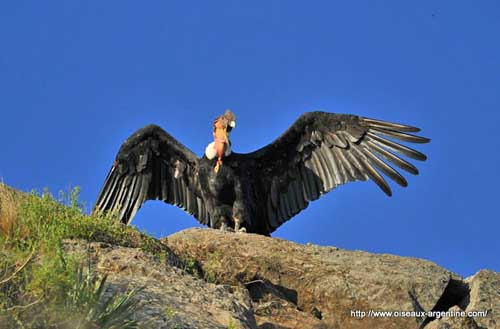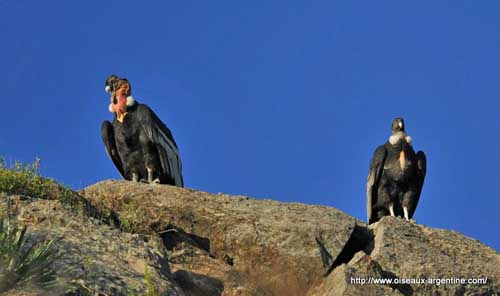Andean Condor
Vultur gryphus
Accipitriforme Order – Cathartidae Family
BIOMETRICS :
Length : 100-130 cm
Wingspan : plus de 320 cm
Weight : M : 11-15 kg – F : 8-11 kg
LONGEVITY: up to 50 years and more in captivity
DESCRIPTION:
Andean Condor is the largest raptor of the world.
Adult male has black plumage overall, except the wings where secondaries and upperwing coverts are greyish white.
We can see a conspicuous white ruff around the neck base.
The black head shows in male a large comb in the middle of the face, and large neck wattles. The bare skin of head and neck may vary from reddish-pink in lower neck, to mottled pinkish or yellow on the head.
The strong, hooked bill is dark grey at base, and whitish to ivory at tip. The eyes are brown. The strong legs and feet are greyish.
Female has similar plumage, but she lacks comb and neck wattles. She has black bare head and reddish eyes. She is smaller than male.
Juvenile is brown with brownish bare skin. Bill, legs and feet are pale grey.
The white ruff appears only at adult age, between six and eight years.
VOICE: SOUNDS BY XENO-CANTO
The Cathartid Vultures are almost silent birds, because they lack the syrinx and the muscles associated to it.
These birds produce some strange hissing, rattling and sneezing noises, but not very loud.
They are mainly “vocal” during the breeding season, and are able to give series of wheezes and snorts in defence of the nest-site.
HABITAT AND RANGE:
Andean Condor frequents mainly the mountainous areas where it can fly in thermal currents. It occurs amongst the higher peaks of the Andes.
It may be found in low grasslands in Argentina, and along the sea coast in Peru and southern Chile.
It occurs in the Andes, from western Venezuela to Tierra del Fuego.
BEHAVIOUR:
Andean Condor feeds on carcasses and it is mainly a scavenger, feeding on dead animals.
This large condor is able to tear muscles and viscera through the skin of the largest carcasses. Around the carcasses, when they are feeding with other vultures’ species, there are some ritual displays in order to recognize the dominant birds, and conflicts are avoided or quickly resolved.
Usually, the largest species are dominant.

Andean Condor may descend to sea-level, and feed on dead whales, seals and seabirds near or along the beaches. Inland, Andean Condor feeds mainly on large ungulates, and today domestic stock, which are important food resources.
Andean Condor roosts in groups in cliff ledges. These large birds have to save energy by avoiding fights at carcasses, soaring in thermals during several hours apparently effortless, and storing fat reserves when food resources are abundant. These vultures can remain several days without feeding.

Large vultures perform sunning behaviour in the morning, because their body temperature falls several degrees at night in order to save the energy. The sun helps them to recover the normal level.
But sunning is also used for feathers. During the flight at high elevation, the strong winds may bend the feather’s tips upwards. Andean Condor needs the sun’s heat for recovering the normal feather’s shape. Feathers’ maintenance is an important behaviour for so large birds.
They do not migrate, but they cover great distances for food resources.
FLIGHT:
Andean Condor spends most of the daytime soaring in the thermals created by valleys and mountains. The large wings are well adapted for soaring flight. They use the rising air currents and rarely perform flapping flight, always in order to save energy.
REPRODUCTION:
Andean Condor male performs courtship displays, by standing erect with opened wings, and producing some clicking noises with the tongue. At this moment, the bare skin of the neck turns bright yellow.
Breeding season occurs from February to June in Peru and in September-October in Chile.
Andean Condor does not build any structure. It nests on the bare ground of cliff-ledges or in shallow caves.
The female lays only one egg. Incubation by both adults lasts about 55 to 58 days. The young is fed by its parents. It fledges six months later and starts to learn how to fly, but it depends on adults for many months more, about one year.
This species cannot breeds every year but every two years under normal conditions.
DIET:
Andean Condor feeds mainly on carcasses of large and medium-sized mammals such as ungulates, guanacos, cattle, but also marine mammals and large seabirds along the coasts.
PROTECTION / THREATS / STATUS:
Andean Condor is threatened by indirect poisoning used for predators, and by the lead in the carcasses.
Disturbances, illegal shooting and persecution play an important role in the declines of this species.
Andean Condor is listed as Endangered and protected under
CITES
Condors regularly appear in pre-Colombian cultures in the Andes, in pottery and textiles. They are very important in mythology too.
Today, it still appears on the coats of arms of Colombia, Bolivia, Ecuador and Chile. It is the powerful symbol of identity for the Andes’ people.
Fr: Condor des Andes
All: Andenkondor
Esp: Cóndor Andino
Ital: Condor delle Ande
Nd: Andescondor
Russe: Андский кондор
Port: Condor-dos-andes
Photographers:
Didier Buysse
Vision d’Oiseaux
Eduardo Andrés Jordan
MIS AVES – AVES DE ARGENTINA
Patrick Ingremeau
TAMANDUA
Philippe et Aline Wolfer
GALERIE
Text and photograhs by Nicole Bouglouan
Sources :
HANDBOOK OF THE BIRDS OF THE WORLD Vol 2 by Josep del Hoyo-Andrew Elliot-Jordi Sargatal - Lynx Edicions - ISBN: 8487334156
A GUIDE TO THE BIRDS OF COLOMBIA by Steven L. Hilty and William L. Brown
Princeton University Press – ISBN 069108372X
BirdLife International (BirdLife International)
Welcome to WhoZoo (Jill Foley)
Wikipedia (Wikipedia, The Free Encyclopedia)
Related pages:
Andean Condor social behaviour